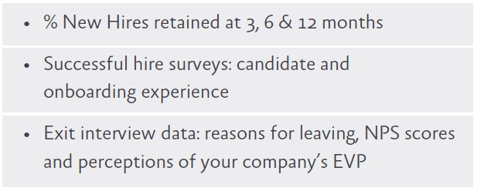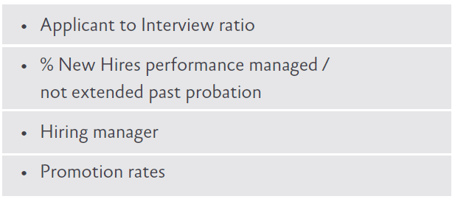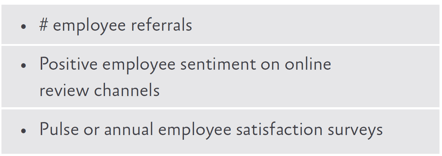How to measure employer branding with 13 must-know metrics
As with any program of work, it’s important to measure the progress and success and your employer brand strategies to determine if they are meeting your objectives.
Common high-level objectives for employer branding include building a positive reputation as an employer, reducing cost-per-hire, and attracting and retaining high-quality talent. How these objectives are achieved, however, is dependent on the individual strategies and tactics employed.
To understand whether your employer branding strategies and employee value proposition (EVP) are effective, you first need to translate your core objectives into actionable strategies and then design useful metrics to measure your progress and success over time.
In an earlier article, we discussed how employer branding is about delivering delightful people experiences and then communicating these effectively. With this in mind, here we talk through some example employer brand objectives with metrics that will deliver useful insights for People & Culture leaders.
Retention
If your employer branding strategies are focused on attracting and retaining talent that is aligned with your organisation’s mission, vision, and values, then you need to be measuring retention. Firstly, it’s helpful to consider retention over the employment lifecycle:
New hire retention is heavily influenced by the recruitment and onboarding process; a key indicator of whether you have delivered on promises made and how well you set people up for success. New-hire retention is also directly linked to quality of hire, which is indicative of the effectiveness of your interviews, assessments and pre-employment checks.
Retention for longer-serving employees will be more closely tied to factors such as career progression and culture. Employee perceptions are reflective of their experiences and formed over time, so retention strategies for longer-serving employees will be a longer-term investment.
Putting it into practice:

Quality of hire
An effective employer branding strategy should improve the quality of candidates that your company attracts. By crafting a highly desirable EVP and communicating it effectively to your target talent markets, you should attract talent that is aligned with your vision and values and has the skills that your business needs to grow and thrive.
Once you have attracted the right people to apply to your organisation, employer brand managers should focus on delivering an exceptional candidate experience and ensuring that hiring teams deliver an on-brand interview process and clearly articulate the organisation’s EVP.
Putting it into practice:

Cost per hire
LinkedIn research shows that a strong employer brand can reduce your cost per hire by 50%. If that’s not a sensible business case for thinking about your EVP and employer brand, then what is?
To calculate your cost per hire, you need accurate data on your internal and external recruitment costs, this includes personnel effort (for ease, let’s say your FTE recruitment team), advertising, technology costs, recruitment agency or search firm fees and the costs of any other licenses or partnerships that you need to manage your hiring process.
A strong employer brand and attractive EVP will help you attract more candidates, for a lower cost. More applicants per job advert, more offers accepted and more candidates reaching out to you directly through employee referrals or proactive approaches.
Cost per hire can be measured as an average across the organisation or, depending on your business operations and strategic priorities, you may want to segment the data into different departments, locations or role types.
Putting it into practice:

Brand awareness and preference
A core focus for employer brand managers is increasing brand awareness; specifically, ensuring that the people you want to work for you are aware of your organisation and interested in what you have to offer. There are many ways to measure and monitor how many people your communications reach and, importantly, how they feel about what you have to say.
Depending on the communications channels that you use, this might include digital and social media listening, Google Analytics or other tools that measure reach, interaction and sentiment, and whether that interest leads to a conversion (a defined action taken by someone in response to your communications, such as clicking on a job advert). For print, radio, outdoor media or television, advertising partners can provide data on expected and/or actual reach.
Measuring brand awareness and preference is essential to measure employer branding strategies, it is also a good way to understand the impacts of business, social and economic changes as well as competitor strategies.
Putting it into practice:

Employee advocacy
When it comes to employer branding, employees are your greatest communications channel. Their experiences and opinions are the authentic voice of your business and if your people love where they work, they are more likely to recommend your workplace to others.
Measuring your volume of employee referrals is a good indicator of employer brand effectiveness, but you can also test the extent to which your EVP is delivered through regular feedback.
Putting it into practice:

The above metrics are just some examples. Depending on your people strategy and areas of desired improvement, you can also consider measuring candidate satisfaction, offer/accept rate, applicant and workforce diversity, time to hire or compare new hire salaries to the market.
Our advice is to start small, keep it simple and focus only on those metrics that provide you with useful insights into the effectiveness of your employer brand strategy. Once you have a reporting rhythm and clean data that helps you make informed decisions, you can progress to a more sophisticated data and analytics regime. Remember, there is no one-size-fits-all reporting dashboard for employer branding – take the time to design a reporting framework that works for you.
If you need a hand to review your analytics suite or design a suite of metrics and reports, we can help. Harrier's experienced analysts specialise in talent and employer brand strategy and are as invested in your performance as you are. Contact us today.
GET STARTED
